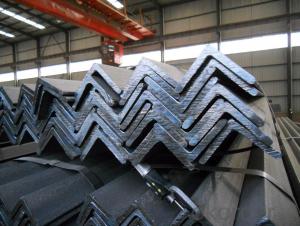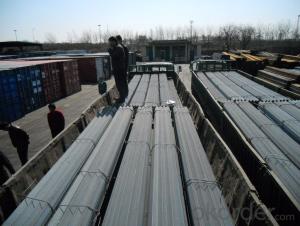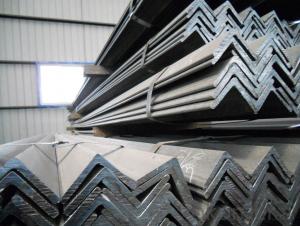Hot Rolled Steel Angle Bar with High Quality 75*75mm
- Loading Port:
- Tianjin
- Payment Terms:
- TT OR LC
- Min Order Qty:
- 25 m.t
- Supply Capability:
- 10000 m.t/month
OKorder Service Pledge
OKorder Financial Service
You Might Also Like
Product Description
Specifications of Equal Angle Steel
1.Standards:GB
2.Length:6m, 12m
3.Material:GBQ235 or Equivalent
4. Size:
Size (mm) | Mass (mm) | Size (mm) | Mass (mm) |
| 75*75*6 | 6.905 | 75*75*8 | 9.03 |
| 75*75*7 | 7.976 |
Usage & Applications of Equal Anlge Steel
Trusses;
Transmission towers;
Telecommunication towers;
Bracing for general structures;
Stiffeners in structural use.
Packaging & Delivery of Equal Angle Steel
1. Transportation: the goods are delivered by truck from mill to loading port, the maximum quantity can be loaded is around 40MTs by each truck. If the order quantity cannot reach the full truck loaded, the transportation cost per ton will be little higher than full load.
2. With bundles and load in 20 feet/40 feet container, or by bulk cargo, also we could do as customer's request.
3. Marks:
Color mark: There will be color marking on both end of the bundle for the cargo delivered by bulk vessel. That makes it easily to distinguish at the destination port.
Tag mark: There will be tag mark tied up on the bundles. The information usually including supplier logo and name, product name, made in China, shipping marks and other information request by the customer.
If loading by container the marking is not needed, but we will prepare it as customers' request.
FAQ:
Q1: Why buy Materials & Equipment from OKorder.com?
A1: All products offered byOKorder.com are carefully selected from China's most reliable manufacturing enterprises. Through its ISO certifications, OKorder.com adheres to the highest standards and a commitment to supply chain safety and customer satisfaction.
Q2: How do we guarantee the quality of our products?
A2: We have established an advanced quality management system which conducts strict quality tests at every step, from raw materials to the final product. At the same time, we provide extensive follow-up service assurances as required.
Q3: How soon can we receive the product after purchase?
A3: Within three days of placing an order, we will arrange production. The shipping date is dependent upon the quatity, how many sizes you want and the plan of production, but is typically 30 to 45 days from the beginning of production.
Images:
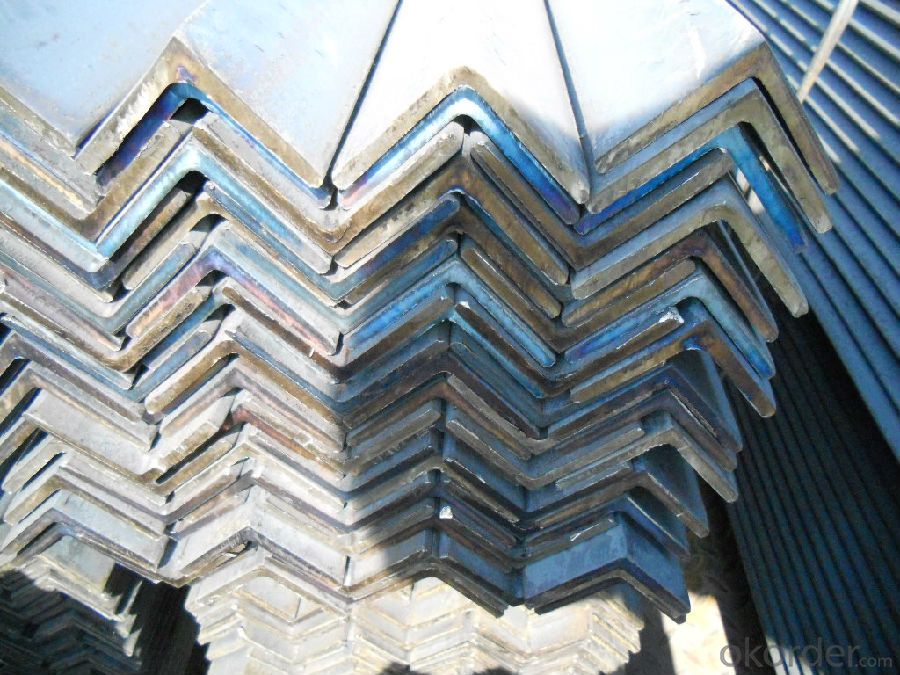
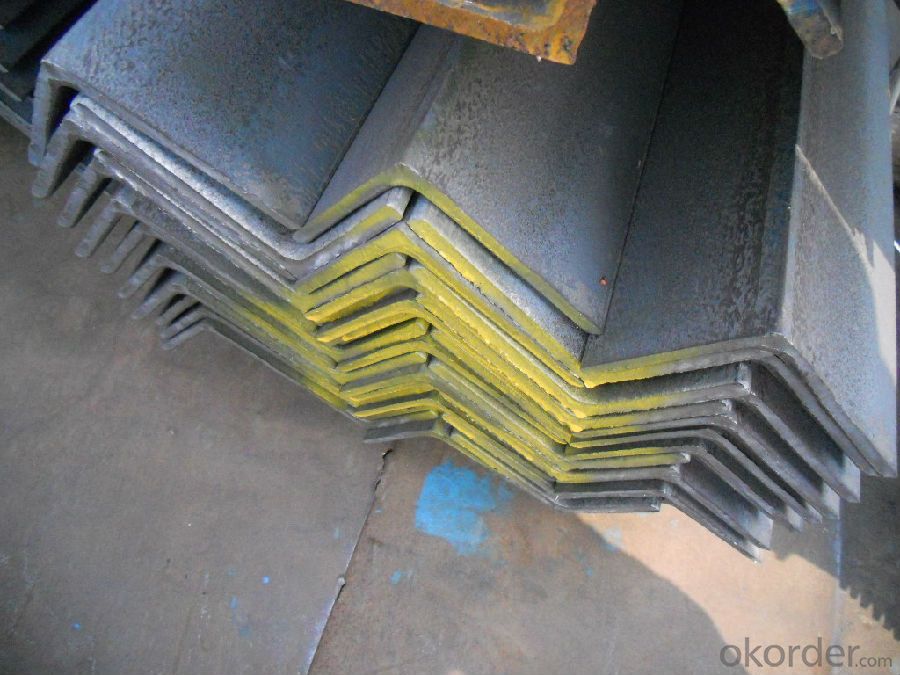
*If you would like to get our price, please inform us the size, standard/material and quantity. Thank you very much for your attention.
- Q:Can steel angles be used for framing or supporting mezzanines or elevated platforms?
- Yes, steel angles can be used for framing or supporting mezzanines or elevated platforms. Steel angles provide structural support, stability, and can be easily connected to other steel components. They are commonly used in construction projects for their strength and versatility.
- Q:Can steel angles be used as supports for beams or columns?
- Yes, steel angles can be used as supports for beams or columns. Steel angles are L-shaped structural members made of steel that have a variety of applications in construction and engineering projects. They are commonly used as supports, especially for beams or columns, due to their strength and stability. Steel angles provide structural support by transferring the load from the beams or columns to the foundation or other structural elements. They are often used as brackets or braces to reinforce the beams or columns and prevent them from buckling or bending under heavy loads. The versatility of steel angles allows them to be easily welded, bolted, or otherwise connected to the beams or columns. They can be customized to fit specific project requirements, allowing for flexibility in design and construction. Additionally, steel angles are durable and resistant to corrosion, making them suitable for both indoor and outdoor applications. They are available in various sizes and thicknesses, enabling engineers and architects to choose the appropriate angle dimensions based on the load and span of the beams or columns. Overall, steel angles are a reliable and cost-effective choice for supporting beams or columns in construction projects, offering strength, stability, and versatility.
- Q:What is the maximum length of a steel angle available in the market?
- The maximum length of a steel angle available in the market can vary depending on the supplier and the specific type of steel angle being referred to. However, in general, steel angles are typically available in lengths ranging from 20 feet (6.1 meters) to 40 feet (12.2 meters). It is important to note that these lengths are commonly found for standard steel angles, but there may be customized options available that could exceed these lengths if required for specific projects or applications. It is advisable to consult with the supplier or manufacturer to determine the maximum length available for a particular steel angle.
- Q:Are steel angles suitable for earthquake-resistant construction?
- Steel angles can indeed be suitable for earthquake-resistant construction. Steel is a material known for its high strength and ductility, making it ideal for withstanding seismic forces. Steel angles, in particular, are commonly used in seismic design and construction due to their ability to provide structural stability. Steel angles are often used as bracing elements in buildings to resist lateral forces caused by earthquakes. They can be installed diagonally between structural members to create a rigid frame that can effectively absorb and dissipate seismic energy. These angles help distribute the forces generated during an earthquake and prevent the collapse of the structure. Furthermore, steel angles can be designed and fabricated to meet specific seismic design criteria. The design can take into account factors such as the building's location, expected seismic activity, and the desired level of earthquake resistance. By using advanced computer-aided design and analysis tools, engineers can optimize the placement and size of steel angles to enhance the overall seismic performance of the structure. In addition to their strength and ductility, steel angles offer other advantages for earthquake-resistant construction. They are lightweight, which reduces the overall weight of the structure and allows for more efficient seismic design. Steel is also a recyclable material, making it a sustainable choice for construction projects. However, it is important to note that the suitability of steel angles for earthquake-resistant construction depends on several factors, including the specific design, construction techniques, and adherence to building codes and regulations. Professional engineering expertise and thorough analysis are necessary to ensure the appropriate use of steel angles in seismic design. In summary, steel angles are suitable for earthquake-resistant construction due to their strength, ductility, and ability to provide structural stability. When properly designed and installed, they can effectively resist seismic forces and contribute to the overall safety and resilience of the structure.
- Q:What is the maximum deflection allowed for steel angles?
- The maximum deflection allowed for steel angles depends on several factors, including the specific grade of steel, the length of the angle, and the applied load. Generally, in structural engineering, deflection limits are set to ensure the safety and performance of the structure. The deflection limit for steel angles is typically defined as a fraction of the span length, such as L/240 or L/360, where L represents the unsupported length of the angle. For example, if the unsupported length of a steel angle is 240 inches, the maximum deflection allowed would be 1 inch (240/240) or 0.67 inches (240/360). However, it is important to note that these deflection limits may vary depending on the specific design codes and standards being used for the project. Consulting the relevant code or seeking guidance from a structural engineer would provide more accurate and specific information regarding the maximum deflection allowed for steel angles in a particular application.
- Q:Can steel angles be used for framing in residential construction?
- Yes, steel angles can be used for framing in residential construction. Steel angles are commonly used as structural elements in construction due to their strength and durability. They can be used to provide support and stability in various framing applications such as wall framing, roof trusses, and floor joists. Steel angles offer several advantages in residential construction, including their resistance to warping, shrinking, and rotting, making them a reliable choice for framing. Additionally, steel angles are fire-resistant, which adds an extra layer of safety in residential buildings. Overall, steel angles are a versatile and cost-effective option for framing in residential construction projects.
- Q:What are the properties of steel angles?
- Steel angles, which are also referred to as angle iron or L-shaped steel, possess numerous qualities that contribute to their extensive use and versatility across various industries. 1. Strength and durability: Solid steel is used to manufacture steel angles, resulting in exceptional strength and durability. These attributes render them suitable for structural applications that demand high strength, such as constructing building frames and supports. 2. Load-bearing capability: The L-shaped design of steel angles enables them to offer excellent load-bearing capacity. They can efficiently distribute weight and provide structural support, making them ideal for the construction of bridges, towers, and other heavy-duty structures. 3. Versatility in applications: The flexibility and adaptability of steel angles allow for their usage in a wide array of applications. They can be easily cut, drilled, and welded, facilitating customization to meet specific project requirements. Commonly employed in the construction, manufacturing, and automotive industries, steel angles showcase their versatility. 4. Resistance to corrosion: Steel angles can be manufactured with corrosion-resistant coatings or can be made from stainless steel. This provides protection against rust and other environmental factors. Thus, they are suitable for outdoor applications and environments with high moisture or chemical exposure. 5. Cost-effectiveness: Comparatively, steel angles are cost-effective when compared to other structural materials like aluminum or wood. They possess a high strength-to-weight ratio, thereby minimizing the amount of material required for a given application. Consequently, steel angles are a cost-efficient choice for various construction projects. 6. Aesthetic appeal: Steel angles can also be utilized for their aesthetic appeal, adding a visually pleasing dimension to architectural designs. They can serve decorative purposes in interior design or as part of ornamental structures, providing both functionality and visual interest. In conclusion, the properties of steel angles, including their strength, load-bearing capacity, versatility, corrosion resistance, cost-effectiveness, and aesthetic appeal, make them an excellent choice for a wide range of applications in different industries.
- Q:Can steel angles be used in framing?
- Indeed, framing can incorporate steel angles. In construction, steel angles are frequently employed to provide structural support and reinforcement. These angles possess adaptability, allowing for simple welding, bolting, or screwing together to construct frames suited for diverse purposes. By incorporating steel angles, structures gain both strength and stability, rendering them suitable for framing walls, ceilings, floors, and other structural elements. Moreover, steel angles are accessible in various sizes and thicknesses, permitting flexibility in design and construction. Ultimately, steel angles are a favored option in framing due to their enduring nature, versatility, and structural characteristics.
- Q:Can steel angles be used in outdoor applications?
- Yes, steel angles can be used in outdoor applications. Steel angles are known for their strength, durability, and resistance to corrosion, making them suitable for various outdoor projects such as construction, infrastructure, and outdoor furniture.
- Q:What are the design considerations for using steel angles in architectural applications?
- When considering the use of steel angles in architectural applications, there are several important design considerations to keep in mind. First and foremost, it is crucial to understand the structural requirements of the application. Steel angles can provide excellent strength and stability, but their suitability for a particular design will depend on factors such as the load-bearing capacity needed and the structural stability required. It is important to consult with a structural engineer to determine the appropriate size, shape, and thickness of the steel angles to ensure they can safely support the intended loads. Another consideration is the aesthetic appeal of the steel angles. While they are primarily chosen for their structural properties, they can also contribute to the overall design and visual impact of a building. Architects can choose from a variety of finishes, including painted, galvanized, or even stainless steel angles, to achieve the desired look. The shape and arrangement of the angles can also be used creatively to enhance the architectural design and create unique visual effects. Durability is another important design consideration. Steel angles are known for their strength and resistance to corrosion, which makes them suitable for various architectural applications. However, depending on the environmental conditions, additional protective measures may be required to prevent rusting or deterioration over time. This can include applying protective coatings or ensuring proper drainage to prevent water accumulation. Ease of fabrication and installation is also an essential consideration. Steel angles can be easily fabricated into various shapes and sizes, allowing for flexibility in design. They can be cut, welded, or bent to meet the specific requirements of the architectural application. Additionally, their standardized sizes and availability make them relatively easy to source and install. Finally, cost considerations should not be overlooked. Steel angles are generally cost-effective compared to other structural materials, such as wood or concrete. However, the overall cost will depend on factors such as the size, finish, and quantity of steel angles required. It is important to strike a balance between the desired design and the available budget. In conclusion, when considering the use of steel angles in architectural applications, it is essential to carefully assess the structural requirements, aesthetics, durability, ease of fabrication and installation, and cost considerations. By taking these design considerations into account, architects can make informed decisions and ensure the successful integration of steel angles into their designs.
1. Manufacturer Overview |
|
|---|---|
| Location | |
| Year Established | |
| Annual Output Value | |
| Main Markets | |
| Company Certifications | |
2. Manufacturer Certificates |
|
|---|---|
| a) Certification Name | |
| Range | |
| Reference | |
| Validity Period | |
3. Manufacturer Capability |
|
|---|---|
| a)Trade Capacity | |
| Nearest Port | |
| Export Percentage | |
| No.of Employees in Trade Department | |
| Language Spoken: | |
| b)Factory Information | |
| Factory Size: | |
| No. of Production Lines | |
| Contract Manufacturing | |
| Product Price Range | |
Send your message to us
Hot Rolled Steel Angle Bar with High Quality 75*75mm
- Loading Port:
- Tianjin
- Payment Terms:
- TT OR LC
- Min Order Qty:
- 25 m.t
- Supply Capability:
- 10000 m.t/month
OKorder Service Pledge
OKorder Financial Service
Similar products
New products
Hot products
Related keywords
